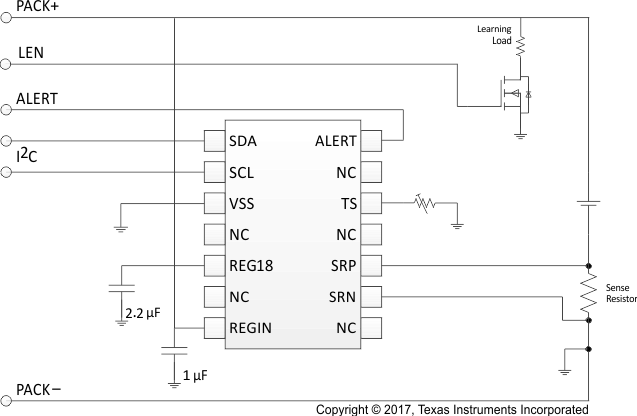ZHCSGI9 August 2017
PRODUCTION DATA.
- 1 特性
- 2 应用
- 3 说明
- 4 修订历史记录
- 5 Pin Configuration and Functions
-
6 Specifications
- 6.1 Absolute Maximum Ratings
- 6.2 ESD Ratings
- 6.3 Recommended Operating Conditions
- 6.4 Thermal Information
- 6.5 Supply Current
- 6.6 Digital Input and Output DC Characteristics
- 6.7 LDO Regulator, Wake-up, and Auto-Shutdown DC Characteristics
- 6.8 LDO Regulator, Wake-up, and Auto-Shutdown AC Characteristics
- 6.9 ADC (Temperature and Cell Measurement) Characteristics
- 6.10 Integrating ADC (Coulomb Counter) Characteristics
- 6.11 I2C-Compatible Interface Communication Timing
- 6.12 SHUTDOWN and WAKE-UP Timing
- 6.13 Typical Characteristics
-
7 Detailed Description
- 7.1 Overview
- 7.2 Functional Block Diagram
- 7.3
Feature Description
- 7.3.1 Device Configuration
- 7.3.2 ALERT Interrupt and SHUTDOWN Wake-up
- 7.3.3 Voltage Measurement and Calibration
- 7.3.4 Temperature Measurement
- 7.3.5 Charging and Termination
- 7.3.6 Accumulated Charge Measurement
- 7.3.7 Gas Gauging
- 7.3.8 Battery Condition Warnings
- 7.3.9 Configuration Update
- 7.3.10 End-Of-Service Determination
- 7.3.11 Battery Level Threshold
- 7.3.12 Communications
- 7.3.13 Additional Data Memory Parameter Descriptions
- 7.4 Device Functional Modes
- 8 Application and Implementation
- 9 Power Supply Recommendation
- 10Layout
- 11器件和文档支持
- 12机械、封装和可订购信息
1 特性
- 符合汽车 AEC-Q100 3 级标准
- 1 芯电池电量监测计支持锂离子、磷酸铁锂和镍氢电池(3 芯)化学物质
- 位于系统板上
- 由具有集成低压降稳压器 (LDO) 的电池直接供电
- 支持低值外部感测电阻器 (10mΩ)
- 从主机学习负载使能 (LEN)
- 超低功耗:正常模式下为 50µA,睡眠模式下为 9µA
- 支持替换电池
- 精准的放电结束 (EOS) 确定功能,适用于极少放电型应用中的 电池
- 用于 1 芯电池的 CEDV 电量监测计,可提供:
- 荷电状态 (SOC)
- 续航时间 (TTE)
- 运行状况 (SOH)
- 高侧和低侧电流感应选项
- 内部温度传感器或外部热敏电阻器
- 微控制器外设接口支持:
- 400kHz I2C™串行接口
- 针对 SOC、电池电量、温度故障和充电/放电状态的可配置中断(警报)
2 应用
- eCall 系统
- 远程信息处理备用系统
- 不间断电源 (UPS) 备用系统
- 应急电池电源模块
3 说明
bq34210-Q1 1 芯系统侧 CEDV 电量监测计为 eCall 系统和电力故障期间的备用不间断电源 (UPS) 等极少放电型 应用 (其中电池可能在其寿命中的大部分时间一直连接到充电电源,直到需要时才断开连接)中的 1 芯电池提供电量监测和放电结束 (EOS) 确定功能。bq34210-Q1 电量监测计支持多种电池化学物质,包括锂离子、磷酸铁锂和镍氢。
电量监测功能使用电压、电流和温度数据以及补偿放电结束电压 (CEDV) 技术来提供荷电状态 (SOC) 和运行状况 (SOH) 数据。该器件的 EOS 确定功能会在电池性能下降并在接近其使用寿命终点时发出警报。
使用 bq34210-Q1 电量监测计进行电池电量监测时,只需将其连接至可拆卸电池组或嵌入式电池管理系统的 PACK+ (P+) 和 PACK- (P-)。
器件信息(1)
| 器件型号 | 封装 | 封装尺寸(标称值) |
|---|---|---|
| bq34210-Q1 | PW (14) | 5.00mm x 4.40mm x 1.00mm |
- 如需了解所有可用封装,请参阅产品说明书末尾的可订购产品附录。
简化原理图

4 修订历史记录
| 日期 | 修订版本 | 注意 |
|---|---|---|
| 2017 年 8 月 | * | 初始发行版 |